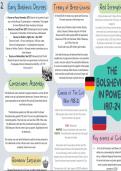2. Early Bolshevik Decrees Treaty of Brest-Litovsk Red Strength
In March1918, the treaty was signed with Germany. -Strong discipline and Trotsky effective
Decree on Peace, November 1917 plea for all countries to pull
The main outcomes of the treaty were: -Bolsheviks controlled most of Russia’s ind
out war like Russia. No annexations + indemnities. They hoped
weapons)
for more Bolshevik-Style revolutions in Europe
-Russia lost all Western lands: Finland, Estonia, -Controlled Centra Russia (shorter distance
Decree on Land, 8 Nov 1917 Distributing the land of wealthy
Latvia, Lithuania, Ukraine and parts of Poland armies and also controlled majority of po
to peasants. In December, church land was nationalised.
-Russia lost 62 million people (26% of population) -Bolshevik formed own powerful fighting
Decree on Worker’s rights, Nov + Dec 1917
-Russia lost 27% of all Farmland, 26% of Railways, conscription and by 1920 had 5 million
Decree of work -> 8 hour working day + 48 hour week.
and 74% of Iron Ore -Bolsheviks worked hard to win suppor
Decree of unemployment -> Unemployment Insurance.
-Russia had to pay 300 million gold roubles propoganda, claimed whites would undo
Decree on Worker Control-> Allowed workers committees to run
their factories.
Lenin did this because he believed that the country
Decree on Nationalities, Nov 1917 Allowed all old Tsarist
needed time to organise and become a more powerful
Russian Empire to have their own government, no Russian rule
country. He also realised if he wanted the Bolsheviks
of language enforced. Allowed own identity. (LIE FOR
to survive he needed to gain the support of the people
THE
POPULARITY)
and focus on threats within Russia. He still believed
that revolution would break out across Europe and
eventually the treaty would be torn up.
Constituent Assembly BOLSHEVI
The Bolsheviks were reluctant to organise elections, as they did not
intend to set up a parliamentary democracy. However, there was a
great expectation to do what the Provisional Government did not
Causes of The Civil
War 1918-21
IN POWER
and hold an election.
The Bolsheviks gained only 168 seats whilst the Soviet
After the fall of the old tsarist empire, everyone had
differing ideas about what to do with the country.
1917-24
Revolutionaries gained 370 seats. The rest was split between the
There were three main groups
remaining parties. They had only won less than 25% of the votes.
The Bolsheviks shut doen the Constituent Assembly in January
REDS- Bolsheviks
1918 because it did not want to give up power. Signalling the end
WHITES- Russian Nationalists and monarchists
of democracy.
GREENS- Armed Peasants and anarchist who fought
The railway war was when Bolsheviks used the railway network to
the reds and whites
Key events of Civil
force Bolshevik control in Russia and in areas where this was not
Nationalists and Conservatives did not want the
accepted, violence was used. In the Ural Mountains and Siberia, the
Bolsheviks power because they opposed their plans
for social change, worker’s influence in industry, white army commanded by Admiral K
peasant seizure of land and the treaty of Brest-Litovsk. set up a Siberian Regional Governmen
Romanov Execution Some Monarchists even wanted to restore the Tsar. His army had some successes against
until a counter-attack broke its pow
There was also the Czech Legion of 40,000 soldiers in summer of 1919.





